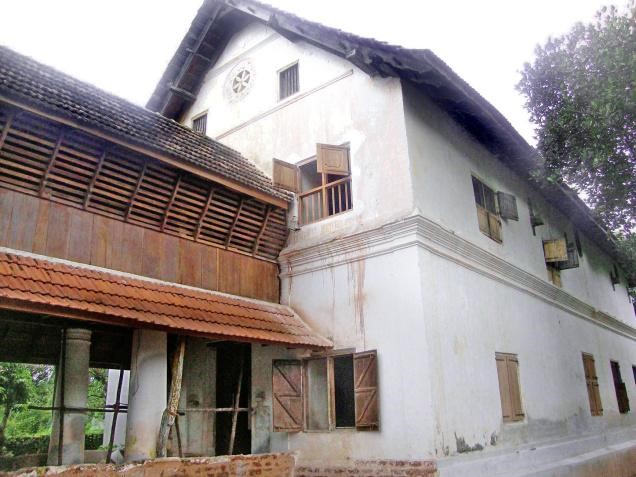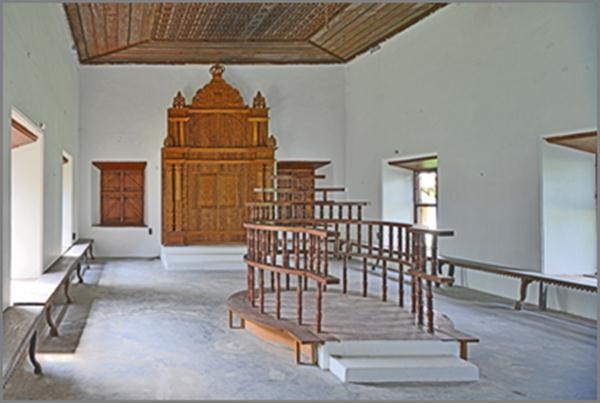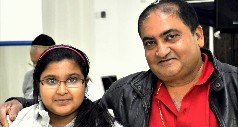PARUR SYNAGOGUE (1616, but rebuilt and altered over the years)
Jew Town (located a short distance away from the commercial center of town)
Paravur (formerly known as Parur)
Kerala, INDIA
This synagogue is no longer a functioning house of prayer but a museum under the control and operated by the State of Kerala government as part of the Muziris Heritage Project. The site is open to visitors daily except Mondays. Request an information sheet prepared by the author of this website and his Friends of Kerala Synagogues colleagues. Hopefully it will still be available since the on-site staff may unfortunately not be versed with the building’s history and significance. The synagogue was restored (with some liberties taken) from 2010 to 2014 with the assistance of the author of this website and his colleagues of the Friends of Kerala Synagogues, and its teak heckal was faithfully recreated by local Hindu craftsmen also through the efforts of the Friends of Kerala Synagogues. The original has been displayed in the Israel Museum in Jerusalem since the early 1990s. Today the synagogue aesthetically appears different from when it was functional since it is now missing an assortment of hanging lights and some liturgical fittings. To visit this and other former synagogues in Kerala outside of Kochi, the services of a car and driver is recommended for a full day. Paravur and nearby Chennamanagalam are about an hour north of Kochi (longer depending on where the trip begins). A public bus can also be taken to Paravur for the more adventurous traveler. Contact the author of this website, Jay A. Waronker at This email address is being protected from spambots. You need JavaScript enabled to view it. for additional information and assistance, and refer to cochinsyn.com.
The synagogue in Parur (now known as Paravur) is the largest of Kerala’s seven extant synagogues and the most architecturally and spatially distinctive. The building complex, central to Parur’s once vibrant Jew Town, represents the most complete and elaborate example of a Jewish house of prayer in Kerala, incorporating influences of design and construction from the Kerala region as well as Jewish building and ceremonial traditions. As a result of this combination, a unique and remarkable style of synagogue architecture can be experienced at this historic site.
From the hustle and bustle of street life, the pace is slowed the moment the synagogue compound is approached and entered at its gatehouse. A shift from the secular world towards the sacred realm within is realized gradually through its series of indoor, covered yet exterior, and outdoor spaces, all ceremoniously and dramatically linked. Within this domain comes a succession of places and spaces vested with spirituality, tranquility, and purpose that are indeed separated from the non-religious outside to the religious inside. These are linked by an axial and formal procession that brings a sense of order as well as pageantry to the synagogue. This straight path has been deliberately set and, clear in its intent, it places the visitor at ease.
It is said that a synagogue was first built here in 1164 following the period of Moorish persecution of the Jews in Cranganore and their eventual shift south to Parur where they could be afforded relative protection by the tolerant Rajah of Cochin. The structure later fell into disrepair.
According to local narratives, the ner tamid, Hebrew for light that always burns, was transferred from the 1164 synagogue and re-hung in the rebuilt 17th century sanctuary. According to this legend, the Jews of Parur offered incense at a local altar said to have had the same dimensions as one at the ancient Temple in Jerusalem. For this act of hubris, evoking rites from a religious ceremony reserved only to the Temple, the legend says the community was devastated by a sudden pestilence, which some of them interpreted as a punishment from heaven. Their 12th century synagogue fell into disuse, and according to the story, the ner tamid was hung out on the street, where an English observer said he saw it nearly two hundred years later. Another version of this tale tells of an epidemic affecting the Parur Jews that could not be stopped. The rabbanim, men versed in Jewish Law, set out to burn ketoret, or incense, as the Israelites did in the wilderness of Sinai when they were affected by a plague. Unable to obtain or unclear about all the necessary ingredients mentioned for this ritual in the Hebrew Bible, they used whatever was locally available. According to the legend, as soon as the incense was lit, hundreds of people died.
David Yaacov Castiel, the fourth mudaliyar (community leader) of the Kerala Jews, was responsible for bringing the rebuilding of the Parur synagogue to fruition in 1616 on the same site. The Hebrew inscription with this date, on a rectangular stone slab, can still be seen, set into the exterior inner wall of the compound.
According to a local Jewish song in Malayalam, a fire damaged the building around 1662, and it was refurbished. The blaze was likely set by the Portuguese who had laid claim to this part of Kerala. They had burned the Paradesi synagogue in Kochi-Jew Town at about the same time.
When Tipu Sultan and his armies invaded Kerala in 1783 during the Second Mysore War, thousands of religious buildings, including Hindu and Jain temples, churches, and synagogues were destroyed. The Parur synagogue was attacked and heavily damaged during this period. Anglican Church missionary Rev. Thomas Dawson, stationed in Kochi beginning in 1817, visited Parur and its synagogue, along with the synagogues in Chendamangalam and Mala. Dawson’s observation seems to confirm that even after the passing of more than a quarter of a century the Parur synagogue had not yet been rebuilt or repaired. Based on Rev. Dawson’s short passage, most of the structure as it stands today, with the possible exception of the gatehouse, was rebuilt no earlier than the 19th century.
When Parur’s synagogue was rebuilt on the same site as the previous structure (an earlier building foundation is still visible immediately adjacent), construction followed Kerala tradition, using locally quarried ashlar laterite stone blocks for the load-bearing walls, which were veneered in chunam (a lime material). These very thick walls were punctuated by deeply-revealed doors and windows. Despite the 17th-century Portuguese aggression against the Kerala Jewish community, the synagogue at Parur incorporated Portuguese-colonial detail, such as the fan-like alette decoration, swirling rope patterns, decorated circular attic vents, and heavily revealed bands of trim on its wall surfaces. With locally cut and crafted wood roof framing exposed at deep eaves in response to the heavy annual monsoons, flat profiled clay roof tiles covering pitched surfaces, and carved wood gablet (shape of the roof) ends, the Parur synagogue is an archetypical example of the vernacular Kerala architectural style. As with other Kerala synagogues, it is made up of not one building, but a collection of structures forming a well-planned and unique compound. Among all extant Kerala synagogues, Parur is notable for the greatest number of connected and consecutive pieces.
Unique to the synagogue at Parur is the way its parts are formally arranged and linked in a highly axial, extended, and ceremonial fashion. As a local building type, there is little doubt that local religious buildings influenced synagogue architecture in the sense that they represented a way to build sacred space. Local design traditions are also evident in the age-old, traditional Kerala materials and construction techniques. The similarities between the design of the Parur Synagogue compound and the ritual linking of spaces that existed in the Court of the Tabernacle and the Temple in Jerusalem are to be considered, as is the terminology for architectural elements in the Parur synagogue that were used for the ancient Temple in Jerusalem.
In 1949, about three hundred Jews were living in Parur. A large number migrated to Israel in the mid-1950s and this trend continued in the 1960s. By the mid-1970s, only a very small community remained in Parur, leaving the congregation unable to form a minyan (a quorum of ten) for religious services and making it difficult to maintain the building. In 2009, the Kerala government negotiated with the Association of Kerala Jews to assume ownership of Parur synagogue, allowing the Jewish community a continuing right of use. A restoration effort began in mid-2010 as part of the Muziris Heritage Site Project, an undertaking of the Kerala and Indian governments. The synagogue complex has now been placed into context among centuries-old traditions and customs of the people of central Kerala to protect and preserve the state’s three thousand year old heritage. Today it serves as a cultural site open to visitors from India and all over the world.

Exterior

Interior








